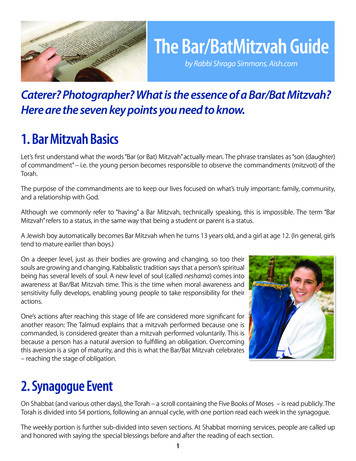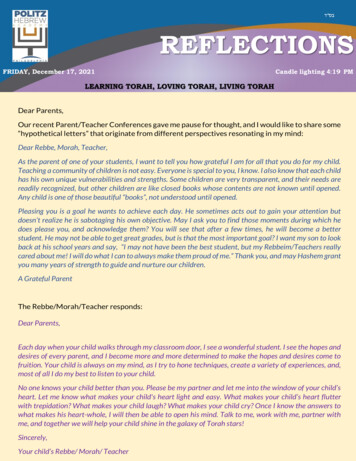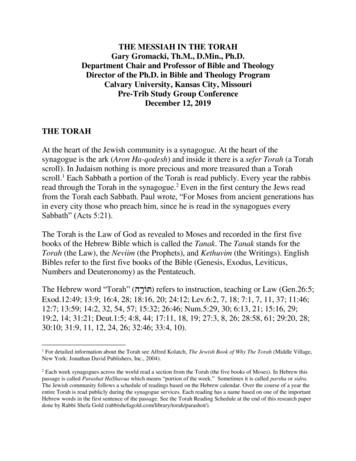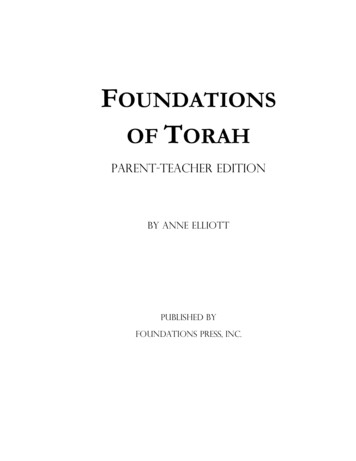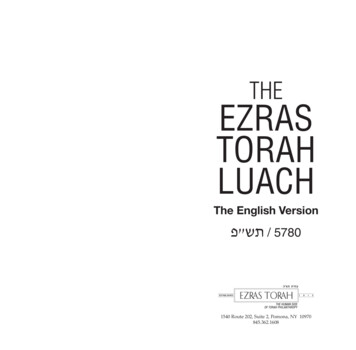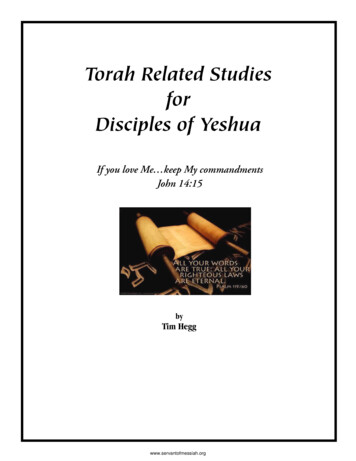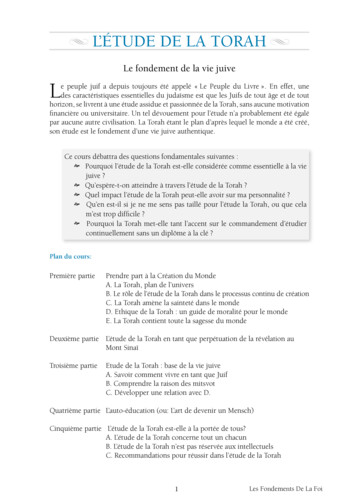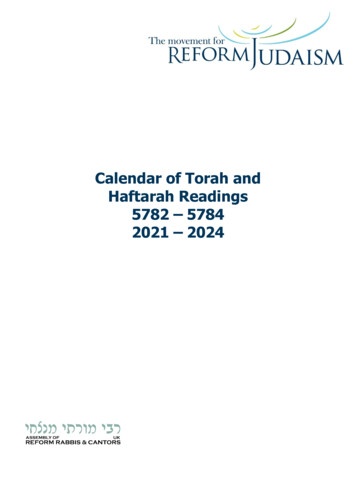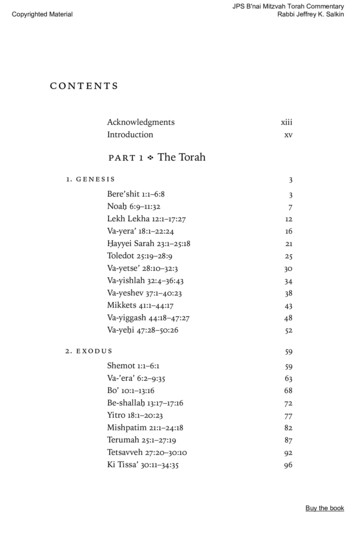
Transcription
JPS B'nai Mitzvah Torah CommentaryRabbi Jeffrey K. SalkinCopyrighted art 1 The Torah1. genesisBere’shit 1:1–6:8Noah. 6:9–11:32Lekh Lekha 12:1–17:27Va-yera’ 18:1–22:24H. ayyei Sarah 23:1–25:18Toledot 25:19–28:9Va-yetse’ 28:10–32:3Va-yishlah 32:4–36:43Va-yeshev 37:1–40:23Mikkets 41:1–44:17Va-yiggash 44:18–47:27Va-yeh. i 47:28–50:262. exodusShemot 1:1–6:1Va-’era’ 6:2–9:35Bo’ 10:1–13:16Be-shallah. 13:17–17:16Yitro 18:1–20:23Mishpatim 21:1–24:18Terumah 25:1–27:19Tetsavveh 27:20–30:10Ki Tissa’ 879296Buy the book
JPS B'nai Mitzvah Torah CommentaryRabbi Jeffrey K. SalkinCopyrighted Materialviii Table of ContentsVa-yakhel 35:1–38:20Pekudei 38:21–40:383. leviticusVa-yikra’ 1:1–5:26Tsav 6:1–8:36Shemini 9:1–11:47Tazria‘ 12:1–13:59Metsora‘ 14:1–15:33’Ah. arei Mot 16:1–18:30Kedoshim 19:1–20:27’Emor 21:1–24:23Be-har 25:1–26:2Be-h. ukkotai 26:3–27:344. numbersBe-midbar 1:1–4:20Naso’ 4:21–7:89Be-ha‘alotekha 8:1–12:16Shelah. Lekha 13:1–15:41Korah. 16:1–18:32H. ukkat 19:1–22:1Balak 22:2–25:9Pinh. as 25:10–30:1Mattot 30:2–32:42Mase‘ei 33:1–36:135. deuteronomyDevarim 1:1–3:22Va-’eth. annan 3:23–7:11‘Ekev 7:12–11:25Re’eh 11:26–16:17Shofetim 16:18–21:9Ki Tetse’ 229233Buy the book
JPS B'nai Mitzvah Torah CommentaryRabbi Jeffrey K. SalkinCopyrighted MaterialTable of ContentsKi Tavo’ 26:1–29:8Nitsavim 29:9–30:20Va-yelekh 31:1–30Ha’azinu 32:1–52Ve-zo’t ha-berakhah 33:1–34:12ix239244250255259Part 2 The Haftarot6. genesisBere’shit: Isaiah 42:5–43:10Noah. : Isaiah 54:1–55:5Lekh Lekha: Isaiah 40:27–41:16Va-yera’: 2 Kings 4:1–37H. ayyei Sarah: 1 Kings 1:1–31Toledot: Malachi 1:1–2:7Va-yetse’: Hosea 12:13–14:10Va-yishlah. : Obadiah 1:1–21Va-yeshev: Amos 2:6–3:8Mikkets: 1 Kings 3:15–28; 4:1Shabbat Hanukkah: Zechariah 2:14–4:7Va-yiggash: Ezekiel 37:15–28Va-yeh. i: 1 Kings 2:1–127. exodusShemot: Isaiah 27:6–28:13; 29:22–23Va-’era’: Ezekiel 28:25–29:21Bo’: Jeremiah 46:13–28Be-shallah. : Judges 4:4–5:31Yitro: Isaiah 6:1–7:6; 9:5–6Mishpatim: Jeremiah 34:8–22; 33:25–26Terumah: 1 Kings 5:26–6:13Tetsavveh: Ezekiel 43:10–27Ki Tissa’: 1 Kings 18:1–39Va-yakhel–Pekudei: 1 Kings 1293293295297299301303305306308310Buy the book
JPS B'nai Mitzvah Torah CommentaryRabbi Jeffrey K. SalkinCopyrighted MaterialxTable of Contents8. leviticusVa-yikra’: Isaiah 43:21–44:23Tsav: Jeremiah 7:21–8:3; 9:22–23Shemini: 2 Samuel 6:1–7:17Tazria‘: 2 Kings 4:42–5:19Metsora‘: 2 Kings 7:3–20’Ah. arei Mot: Ezekiel 22:1–19Kedoshim: Amos 9:7–15’Emor: Ezekiel 44:15–31Be-har: Jeremiah 32:6–27Be-h. ukkotai: Jeremiah 16:19–17:149. numbersBe-midbar: Hosea 2:1–22Naso’: Judges 13:2–25Be-ha‘alotekha: Zechariah 2:14–4:7Shelah. -Lekha: Joshua 2:1–24Korah. : 1 Samuel 11:14–12:22H. ukkat: Judges 11:1–33Balak: Micah 5:6–6:8Pinh. as: 1 Kings 18:46–19:21Mattot: Jeremiah 1:1–2:3Mase‘ei: Jeremiah 2:4–28; 3:410. deuteronomyDevarim: Isaiah 1:1–27Va-eth. annan: Isaiah 40:1–26‘Ekev: Isaiah 49:14–51:3Re’eh: Isaiah 54:11–55:5Shofetim: Isaiah 51:12–52:12Ki Tetse’: Isaiah 54:1–10Ki Tavo’: Isaiah 60:1–22Nitsavim–Va-yelekh: Isaiah 61:10–63:9Ha’azinu: 2 Samuel 68370Buy the book
JPS B'nai Mitzvah Torah CommentaryRabbi Jeffrey K. SalkinCopyrighted MaterialTable of Contents11. special haftarot for major holidaysxi373Mah. ar H. odesh: 1 Samuel 20:18–42Shabbat Parah: Ezekiel 36:16–38Shabbat Shekalim: 2 Kings 12:1–17Rosh H. odesh: Isaiah 66:1–24373375376378Notes381Buy the book
Copyrighted MaterialJPS B'nai Mitzvah Torah CommentaryRabbi Jeffrey K. SalkinintroductionNews flash: the most important thing about becoming bar or bat mitzvah isn’t the party. Nor is it the presents. Nor even being able to celebrate with your family and friends—as wonderful as those thingsare. Nor is it even standing before the congregation and reading theprayers of the liturgy—as important as that is.No, the most important thing about becoming bar or bat mitzvahis sharing Torah with the congregation. And why is that? Because ofall Jewish skills, that is the most important one.Here is what is true about rites of passage: you can tell what a culture values by the tasks it asks its young people to perform on their wayto maturity. In American culture, you become responsible for driving,responsible for voting, and yes, responsible for drinking responsibly.In some cultures, the rite of passage toward maturity includes somekind of trial, or a test of strength. Sometimes, it is a kind of “outwardbound” camping adventure. Among the Maasai tribe in Africa, it is traditional for a young person to hunt and kill a lion. In some Hispaniccultures, fifteen year-old girls celebrate the quinceañera, which markstheir entrance into maturity.What is Judaism’s way of marking maturity? It combines both ofthese rites of passage: responsibility and test. You show that you are onyour way to becoming a responsible Jewish adult through a public test ofstrength and knowledge—reading or chanting Torah, and then teaching it to the congregation.This is the most important Jewish ritual mitzvah (commandment), and that is how you demonstrate that you are, truly, bar orbat mitzvah—old enough to be responsible for the mitzvot.What Is Torah?So, what exactly is the Torah? You probably know this already, butlet’s review.xvBuy the book
Copyrighted MaterialxviJPS B'nai Mitzvah Torah CommentaryRabbi Jeffrey K. SalkinIntroductionThe Torah (teaching) consists of “the five books of Moses,” sometimes also called the chumash (from the Hebrew word chameish, whichmeans “five”), or, sometimes, the Greek word Pentateuch (whichmeans “the five teachings”).Here are the five books of the Torah, with their common namesand their Hebrew names. Genesis (The beginning), which in Hebrew is Bere’shit (from thefirst words—“When God began to create”). Bere’shit spans the yearsfrom Creation to Joseph’s death in Egypt. Many of the Bible’s beststories are in Genesis: the creation story itself; Adam and Eve in theGarden of Eden; Cain and Abel; Noah and the Flood; and the tales ofthe Patriarchs and Matriarchs, Abraham, Isaac, Jacob, Sarah, Rebekah,Rachel, and Leah. It also includes one of the greatest pieces of worldliterature, the story of Joseph, which is actually the oldest completenovel in history, comprising more than one-quarter of all Genesis. Exodus (Getting out), which in Hebrew is Shemot (These are thenames). Exodus begins with the story of the Israelite slavery in Egypt.It then moves to the rise of Moses as a leader, and the Israelites’ liberation from slavery. After the Israelites leave Egypt, they experiencethe miracle of the parting of the Sea of Reeds (or “Red Sea”); the giving of the Ten Commandments at Mount Sinai; the idolatry of theGolden Calf; and the design and construction of the Tabernacle and ofthe ark for the original tablets of the law, which our ancestors carriedwith them in the desert. Exodus also includes various ethical and civillaws, such as “You shall not wrong a stranger or oppress him, for youwere strangers in the land of Egypt” (22:20). Leviticus (about the Levites), or, in Hebrew, Va-yikra’ (And Godcalled). It goes into great detail about the kinds of sacrifices thatthe ancient Israelites brought as offerings; the laws of ritual purity; the animals that were permitted and forbidden for eating(the beginnings of the tradition of kashrut, the Jewish dietarylaws); the diagnosis of various skin diseases; the ethical laws ofholiness; the ritual calendar of the Jewish year; and various agricultural laws concerning the treatment of the Land of Israel. Leviticus is basically the manual of ancient Judaism.Buy the book
Copyrighted MaterialJPS B'nai Mitzvah Torah CommentaryRabbi Jeffrey K. SalkinIntroductionxvii Numbers (because the book begins with the census of the Israelites), or, in Hebrew, Be-midbar (In the wilderness). The bookdescribes the forty years of wandering in the wilderness and thevarious rebellions against Moses. The constant theme: “Egyptwasn’t so bad. Maybe we should go back.” The greatest rebellionagainst Moses was the negative reports of the spies about theLand of Israel, which discouraged the Israelites from wanting tomove forward into the land. For that reason, the “wilderness generation” must die off before a new generation can come into maturity and finish the journey. Deuteronomy (The repetition of the laws of the Torah), or, inHebrew, Devarim (The words). The final book of the Torah is,essentially, Moses’s farewell address to the Israelites as they prepare to enter the Land of Israel. Here we find various laws thathad been previously taught, though sometimes with differentwording. Much of Deuteronomy contains laws that will be important to the Israelites as they enter the Land of Israel—lawsconcerning the establishment of a monarchy and the ethics ofwarfare. Perhaps the most famous passage from Deuteronomycontains the Shema, the declaration of God’s unity and uniqueness, and the Ve-ahavta, which follows it. Deuteronomy ends withthe death of Moses on Mount Nebo as he looks across the JordanValley into the land that he will not enter.Jews read the Torah in sequence—starting with Bere’shit right after Simchat Torah in the autumn, and then finishing Devarim on thefollowing Simchat Torah. Each Torah portion is called a parashah (division; sometimes called a sidrah, a place in the order of the Torahreading). The stories go around in a full circle, reminding us that wecan always gain more insights and more wisdom from the Torah. Thismeans that if you don’t “get” the meaning this year, don’t worry—itwill come around again.And What Else? The HaftarahWe read or chant the Torah from the Torah scroll—the most sacredthing that a Jewish community has in its possession. The Torah isBuy the book
Copyrighted MaterialJPS B'nai Mitzvah Torah CommentaryRabbi Jeffrey K. Salkinxviii Introductionwritten without vowels, and the ability to read it and chant it is partof the challenge and the test.But there is more to the synagogue reading. Every Torah readinghas an accompanying haftarah reading. Haftarah means “conclusion,”because there was once a time when the service actually ended withthat reading. Some scholars believe that the reading of the haftarahoriginated at a time when non-Jewish authorities outlawed the reading of the Torah, and the Jews read the haftarah sections instead. Infact, in some synagogues, young people who become bar or bat mitzvah read very little Torah and instead read the entire haftarah portion.The haftarah portion comes from the Nevi’im, the prophetic books,which are the second part of the Jewish Bible. It is either read orchanted from a Hebrew Bible, or maybe from a booklet or a photocopy.The ancient sages chose the haftarah passages because their themesreminded them of the words or stories in the Torah text. Sometimes,they chose haftarot with special themes in honor of a festival or anupcoming festival.Not all books in the prophetic section of the Hebrew Bible consistof prophecy. Several are historical. For example:The book of Joshua tells the story of the conquest and settlementof Israel.The book of Judges speaks of the period of early tribal rulers whowould rise to power, usually for the purpose of uniting the tribes inwar against their enemies. Some of these leaders are famous: Deborah, the great prophetess and military leader, and Samson, the biblical strong man.The books of Samuel start with Samuel, the last judge, and thenmove to the creation of the Israelite monarchy under Saul and David(approximately 1000 bce).The books of Kings tell of the death of King David, the rise ofKing Solomon, and how the Israelite kingdom split into the Northern Kingdom of Israel and the Southern Kingdom of Judah (approximately 900 bce).And then there are the books of the prophets, those spokesmen forGod whose words fired the Jewish conscience. Their names are immortal: Isaiah, Jeremiah, Ezekiel, Amos, Hosea, among others.Buy the book
Copyrighted MaterialJPS B'nai Mitzvah Torah CommentaryRabbi Jeffrey K. SalkinIntroductionxixSomeone once said: “There is no evidence of a biblical prophetever being invited back a second time for dinner.” Why? Becausethe prophets were tough. They had no patience for injustice, apathy, or hypocrisy. No one escaped their criticisms. Here’s whatthey taught: God commands the Jews to behave decently toward one another.In fact, God cares more about basic ethics and decency thanabout ritual behavior. God chose the Jews not for special privileges, but for special duties to humanity. As bad as the Jews sometimes were, there was always the possibility that they would improve their behavior. As bad as things might be now, it will not always be that way.Someday, there will be universal justice and peace. Human history is moving forward toward an ultimate conclusion that somecall the Messianic Age: a time of universal peace and prosperityfor the Jewish people and for all the people of the world.Your Mission—To Teach Torah to the CongregationOn the day when you become bar or bat mitzvah, you will be reading, or chanting, Torah—in Hebrew. You will be reading, or chanting,the haftarah—in Hebrew. That is the major skill that publicly marksthe becoming of bar or bat mitzvah. But, perhaps even more important than that, you need to be able to teach something about the Torah portion, and perhaps the haftarah as well.And that is where this book comes in. It will be a very valuable resource for you, and your family, in the b’nai mitzvah process.Here is what you will find in it: A brief summary of every Torah portion. This is a basic overviewof the portion; and, while it might not refer to everything in theTorah portion, it will explain its most important aspects. A list of the major ideas in the Torah portion. The purpose: tomake the Torah portion real, in ways that we can relate to. Every Torah portion contains unique ideas, and when you put allBuy the book
Copyrighted MaterialxxJPS B'nai Mitzvah Torah CommentaryRabbi Jeffrey K. SalkinIntroductionof those ideas together, you actually come up with a list of Judaism’s most important ideas. Two divrei Torah (“words of Torah,” or “sermonettes”) for eachportion. These divrei Torah explain significant aspects of the Torah portion in accessible, reader-friendly language. Each devar Torah contains references to traditional Jewish sources (those thatwere written before the modern era), as well as modern sourcesand quotes. We have searched, far and wide, to find sources thatare unusual, interesting, and not just the “same old stuff” thatmany people already know about the Torah portion. Why did weinclude these minisermons in the volume? Not because we wantyou to simply copy those sermons and pass them off as yourown (that would be cheating), though you are free to quote fromthem. We included them so that you can see what is possible—how you can try to make meaning for yourself out of the wordsof Torah. Connections: This is perhaps the most valuable part. It’s a listof questions that you can ask yourself, or that others might helpyou think about—any of which can lead to the creation of yourdevar Torah.Note: you don’t have to like everything that’s in a particular Torah portion. Some aren’t that loveable. Some are hard to understand;some are about religious practices that people today might find confusing, and even offensive; some contain ideas that we might find totally outmoded.But this doesn’t have to get in the way. After all, most kids spend alot of time thinking about stories that contain ideas that modern people would find totally bizarre. Any good medieval fantasy story fallsinto that category.And we also believe that, if you spend just a little bit of time withthose texts, you can begin to understand what the author was trying to say.This volume goes one step further. Sometimes, the haftarah comesoff as a second thought, and no one really thinks about it. We havetried to solve that problem by including a summary of each haftarah,Buy the book
Copyrighted MaterialJPS B'nai Mitzvah Torah CommentaryRabbi Jeffrey K. SalkinIntroductionxxiand then a mini-sermon on the haftarah. This will help you learnhow these sacred words are relevant to today’s world, and even toyour own life.All Bible quotations come from the njps translation, which is foundin the many different editions of the JPS Tanakh; in the Conservative movement’s Etz Hayim: Torah and Commentary; in the Reform movement’s Torah: A Modern Commentary; and in other Bible commentariesand study guides.How Do I Write a Devar Torah?It really is easier than it looks.There are many ways of thinking about the devar Torah. It is, ofcourse, a short sermon on the meaning of the Torah (and, perhaps,the haftarah) portion. It might even be helpful to think of the devarTorah as a “book report” on the portion itself.The most important thing you can know about this sacred task is:Learn the words. Love the words. Teach people what it could mean tolive the words.Here’s a basic outline for a devar Torah:“My Torah portion is (name of portion) ,from the book of , chapter.“In my Torah portion, we learn that(Summary of portion)“For me, the most important lesson of this Torah portion is (whatis the best thing in the portion? Take the portion as a whole;your devar Torah does not have to be only, or specifically, on theverses that you are reading).“As I learned my Torah portion, I found myself wondering: Raise a question that the Torah portion itself raises. “Pick a fight” with the portion. Argue with it. Answer a question that is listed in the “Connections” section ofeach Torah portion. Suggest a question to your rabbi that you would want the rabbito answer in his or her own devar Torah or sermon.Buy the book
Copyrighted MaterialJPS B'nai Mitzvah Torah CommentaryRabbi Jeffrey K. Salkinxxii Introduction“I have lived the values of the Torah by(here, you can talk about how theTorah portion relates to your own life. If you have done a mitzvah project, you can talk about that here).How To Keep It from Being Boring(and You from Being Bored)Some people just don’t like giving traditional speeches. From our perspective, that’s really okay. Perhaps you can teach Torah in a differentway—one that makes sense to you. Write an “open letter” to one of the characters in your Torah portion. “Dear Abraham: I hope that your trip to Canaan was not toohard . . .” “Dear Moses: Were you afraid when you got the TenCommandments on Mount Sinai? I sure would have been . . .” Write a news story about what happens. Imagine yourself tobe a television or news reporter. “Residents of neighboring cities were horrified yesterday as the wicked cities of Sodom andGomorrah were burned to the ground. Some say that God wasresponsible . . .” Write an imaginary interview with a character in your Torah portion. Tell the story from the point of view of another character, or a minor character, in the story. For instance, tell the story of the Garden of Eden from the point of view of the serpent. Or the storyof the Binding of Isaac from the point of view of the ram, whichwas substituted for Isaac as a sacrifice. Or perhaps the story ofthe sale of Joseph from the point of view of his coat, which wasstripped off him and dipped in a goat’s blood. Write a poem about your Torah portion. Write a song about your Torah portion. Write a play about your Torah portion, and have some friends actit out with you. Create a piece of artwork about your Torah portion.The bottom line is: Make this a joyful experience. Yes—it couldeven be fun.Buy the book
Copyrighted MaterialJPS B'nai Mitzvah Torah CommentaryRabbi Jeffrey K. SalkinIntroduction xxiiiThe Very Last Thing You Need to Know at This PointThe Torah scroll is written without vowels. Why? Don’t sofrim (Torahscribes) know the vowels?Of course they do.So, why do they leave the vowels out?One reason is that the Torah came into existence at a time whensages were still arguing about the proper vowels, and the properpronunciation.But here is another reason: The Torah text, as we have it today, andas it sits in the scroll, is actually an unfinished work. Think of it: thewords are just sitting there. Because they have no vowels, it is as ifthey have no voice.When we read the Torah publicly, we give voice to the ancient words.And when we find meaning in those ancient words, and we talk aboutthose meanings, those words jump to life. They enter our lives. Theymake our world deeper and better.Mazal tov to you, and your family. This is your journey toward Jewish maturity. Love it.Buy the book
Copyrighted MaterialJPS B'nai Mitzvah Torah CommentaryRabbi Jeffrey K. Salkingenesis Bere’shit: Genesis 1:1–6:8This is how it all starts—with a Torah portion that poses a lot of questions. God creates the world in six days (right, but how long was aday?). God rests on the seventh day, which is how Shabbat gets started.God then creates Adam and Eve and places them in the Garden of Eden.Things are going great until Adam and Eve disobey God by eatingfrom the Tree of Knowledge of Good and Evil. God kicks them outof the garden. Just when you think things are bad enough, Cain killshis brother, Abel. As punishment, Cain is condemned to wander theearth. And over the next several generations, humanity increasinglydescends into violence.Maybe the whole “humanity” project isn’t working out as well asGod had planned. Stay tuned for God’s solution to the problem.Summary God creates the universe as we know it in a series of six days.(1:1–29) Human beings are created in the image of God. (1:26–28) The seventh day of creation is a day of rest—Shabbat—and Goddeclares it holy. (2:1–3) Human beings had a special role in the Garden of Eden, and Godcommands them not to eat from the Tree of Knowledge of Goodand Evil. The snake convinces Adam and Eve to disobey God’scommand, with severe consequences that include expulsion fromthe garden. (2:4–3:24) Cain kills his brother, Abel, and God confronts him. From there,things go downhill fast and humanity increasingly descends intoviolence. (4:1–6:8)3Buy the book
Copyrighted Material4JPS B'nai Mitzvah Torah CommentaryRabbi Jeffrey K. SalkinGenesisThe Big Ideas The story of creation in Genesis is a moral story, about the nature of the world and of humanity itself. It contains ethicalteachings about the pattern of creation and the meaning of theworld itself. God created order out of chaos. We don’t know how long a daywas, but the most important thing is that there is a rhythm andpattern to creation, and that things do not simply happen in arandom way. Language is a tool of creation. That is precisely how God useslanguage: “Let there be . . .” The words that we say have thepower to create worlds, or, if we use words irresponsibly, theycan destroy worlds—and people—as well. Nature must be respected. We are not free to do whatever wewant to the earth, its living things, and its resources. Becausethe earth is God’s creation, we must respect it and take care of it,which was one of God’s commandments to Adam and Eve in theGarden of Eden. Special times can be holy. The first thing declared holy in the Torah is not a place nor a person, but a time. The seventh day isholy and set apart because God rested on that day. When we reston Shabbat we too make it a holy—a special—day. Human beings are responsible for one another. The Torah tellsus that humanity is made in God’s image, and one way of interpreting this is that there is a piece of God within us all. In somedeep way, we are all connected to each other and to God, andwe should treat one other as we want to be treated, and as Godwould want to be treated.Divrei Torahin god’s image: what does it mean?The last thing that God creates is humanity. The Torah suggests thatperhaps God saved the best for last. We are uniquely described as created in God’s image: “And God created humankind in the divine image,creating it in the image of God—creating them male and female” (1:27).This is perhaps the greatest idea that Judaism ever gave to theBuy the book
Copyrighted MaterialJPS B'nai Mitzvah Torah CommentaryRabbi Jeffrey K. SalkinBere’shit 1:1–6:85world—that every person has the spark of divinity within him or her.The great sage Rabbi Akiba recognized that our awareness of this sparkmakes us even more special: “Beloved are human beings, because theywere created in the divine image. But it was through a special lovethat they became aware that they were created in the divine image.”What does this really mean—“in the divine image”?On its most basic level, it means that while we are certainly notGod, in some way we resemble God. It means that we should try toimitate God. A large part of our human responsibilities flow from thevarious things that God does in the Torah. Our tradition teaches thatas God creates, we can create. As God clothes Adam and Eve, so wecan clothe the needy. As God gives life, so we strive to heal the sick.Being made in God’s image means that we have special tasks andopportunities in the world. We have a special responsibility to carefor all of God’s creation. Because God created the world and all livingthings within it, we must avoid destruction of the earth and its plantlife (ba’al tashhit). Because God created and blessed animals (1:22), wemust avoid cruelty to animals (tza’ar ba’alei chayyim). Because God created, blessed, and made human beings in the divine image, we mustrecognize the sacred in all human beings and cherish them. Yes, toavoid destruction, and yes, to avoid cruelty—but also to create waysof helping people through acts of kindness (gemilut chasadim).Note that the Torah teaches that both man and woman are madein the divine image. All people are equal in dignity and deserve equalrespect and opportunity. In the words of Rabbi Irving (Yitz) Greenberg, in an imitation of the American Declaration of Independence,which also speaks of basic rights: “We hold these truths to be selfevident: that all human beings are created in the image of God, thatthey are endowed by their Creator with certain fundamental dignities, that among these are infinite value, equality and uniqueness.Our faith calls on all humanity to join in a covenant with God and apartnership between the generations for tikkun olam (the repair of theworld) so that all forms of life are sustained in the fullest of dignity.”So, that is the Jewish task: to work toward a world where everyone knows that he or she is created in the divine image. And a worldwhere everyone else knows it as well!Buy the book
Copyrighted Material6JPS B'nai Mitzvah Torah CommentaryRabbi Jeffrey K. SalkinGenesiswhere is your brother?In one sense, Cain was the first and worst murderer in the world. Whenhe killed his brother, Abel, he essentially wiped out one-quarter of allhumanity, because the Torah claims that at that time there were onlyfour people in the world: Adam, Eve, Cain, and Abel.Both Cain and Abel brought offerings to God. God accepted Abel’soffering of a lamb, but rejected Cain’s offering of grain. Cain is veryjealous, and very angry.God warned Cain that “sin crouches at the door”—that we haveto be careful of our feelings of anger and jealousy. It was too late forCain to engage in “anger management.” Cain killed Abel. God askedCain: “Where is your brother Abel?” (4:9). To which Cain responded:“I don’t know. Am I my brother’s keeper?”Of course, God knew where Abel was. (God is, after all, God, whoknows everything.) God simply wanted Cain to own up to what hehad done, and to learn the lesson of moral responsibility.More than this: God wanted Cain to know that he had not onlykilled Abel. The text says that Abel’s bloods (demei) cried out fromthe ground—a strange way of putting it, especially since “blood” isone of those words that has no plural form. A midrash explains it thisway: “It is not written, ‘Your brother’s blood cries out to me from theground!’ but ‘your brother’s bloods’—not only his blood, but also theblood of his descendants.”The tragedy of it all is that Cain not only took his brother’s life, butalso cut off his brother’s line forever, and then evaded responsibility.God spared Cain’s life, however, while putting a mark on him. One wonders: Did Cain learn his lesson in any way? As Rabbi Marshall Meyersaid: “True hope is born when I learn to scream no to injustice, to bribery, to corruption; when I scream that I will be involved; when I screamthat I won’t stay frozen in my ways. True hope is born when I can screamwith all my being: yes to honesty; yes, I am my brother’s keeper!”Connections In many places in the United States, people think that schoolsshould teach the biblical version of creation, as well as the theoryof evolution. How do you feel about this?Buy the book
Copyrighted MaterialJPS B'nai Mitzvah Torah CommentaryRabbi Jeffrey K. SalkinNoah. 6:9–11:327 Why is Shabbat important to the Jewish people? Is it importantto you and your family? How do you make it so? What do youthink an ideal Shabbat would be like? What does being created in the divine image mean to you? Whatare some examples of ways that we can show that people aremade in the divine image? What are some of the implications of the way that we are supposed to care for the earth? For animals? Is it a violation of tza’arba’alei chayyim (avoid cruelty to animals) to experiment on animals for medical research? What about for cosmetic research? We might think of the entire Torah as the answer to God’s question to Cain: “Where is Abel your brother?” What are some waysthis is so? Noah.: Genesis 6:9–11:32There is an old comedy bit that includes these famous words: “Hey,Noah—how long can you tread water?” That’s a good question for thisT
The Torah (teaching) consists of "the five books of Moses," some-times also called the chumash (from the Hebrew word chameish, which means "five"), or, sometimes, the Greek word Pentateuch (which means "the five teachings"). Here are the five books of the Torah, with their common names and their Hebrew names.

